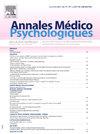人格障碍和食管过度通路的共同发生:临床问题和心理治疗干预的途径
IF 0.5
4区 医学
Q4 PSYCHIATRY
引用次数: 0
摘要
人格障碍(pd)通常与许多生理和心理合并症有关,其中之一是反复出现的暴饮暴食(BE)。虽然造成BE的原因多种多样且复杂,但众所周知的触发BE的因素包括所谓的暴食-限制循环和高负性情绪负荷的存在(例如悲伤、焦虑、孤独),这有时会导致BE发作期间的分离状态。据报道,pd患者中BE的流行率比社区样本高出15倍。pd的存在还与BE的更高频率和严重程度以及对体重和身体外观的更高关注有关。目的本文的目的是介绍目前关于pd和BE共存的知识状况,并探索有希望的心理治疗途径,以帮助改善这类患者的生活质量。结果pd与BE的高度共现可能是由于两者具有许多共同特征,如较大的冲动性、情绪调节问题、人际关系中的各种困难等。它们还都与创伤史(例如,虐待、忽视、欺凌)有关,这些创伤史在成年后会转变为不安全的依恋类型。在复发性BE患者中最常观察到的PD,按重要性排序,是回避型PD,边缘型PD和强迫性PD。然而,pd和BE通常通过不同的方法分开治疗。不幸的是,当一个人同时患有PD时,通常的BE治疗方法似乎效果不佳,导致更多的先前治疗,以及更大的残余进食病理和治疗结束时的负面影响。相反,似乎更可取的治疗方法是针对BE和pd的共同特征(即冲动、情绪调节、人际关系)。幸运的是,越来越多最初为pd开发的心理疗法(正是针对这些常见的困难)现在也被用于治疗饮食失调。图式疗法似乎是一种很有前途的治疗方法,但由于研究数量较少,需要对结果进行谨慎的解释。基于心理的治疗(MBT)是一种针对pd的循证治疗方法,最近还提供了一种针对饮食失调(MBT- ed)的手动适应方法,使其更容易适用于治疗BE。辩证行为疗法(DBT)得到了很好的验证和经验支持,甚至为BE提供了两种特定的适应。第一个改编是斯坦福模型,专门用于治疗贪食症和BE。它认为BE是一种无效和不适当的调节情绪的方式,并旨在用危害较小的策略来取代它。第二项调整是DBT模型的多诊断复杂饮食失调,旨在治疗需要额外护理的复杂饮食失调合并症。这种适应结合了认知行为疗法治疗饮食失调行为的原则和原始DBT管理风险行为和提高情绪调节技能的原则。这两种适应都有多种益处(例如,减少BE和住院治疗,改善情绪调节)。在PD和BE并存的情况下,重点关注治疗这两种疾病的共同困难似乎至关重要。幸运的是,越来越多的选择是可用的,因为一些最初用于治疗pd的心理疗法现在为BE提供了特定的和手动的适应。本文章由计算机程序翻译,如有差异,请以英文原文为准。
Cooccurrence de troubles de la personnalité et d’accès hyperphagiques : enjeux cliniques et pistes d’intervention psychothérapeutique
Background
Personality disorders (PDs) are often associated with numerous physical and psychological comorbidities, one of which is the recurrent presence of binge eating (BE). While the causes of BE are multiple and complex, well-known triggers of BE include the so-called binge-restrict cycle and the presence of a high negative emotional load (e.g. sadness, anxiety, loneliness), which may sometimes lead to a dissociative state during the BE episode. The prevalence of BE in people with PDs is reported to be up to 15 times greater than in community samples. The presence of PDs is also associated with a greater frequency and severity of BE, as well as a higher preoccupation towards weight and body appearance.
Objective
The aim of this article is to present the current state of knowledge regarding the co-occurrence of PDs and BE, and to explore promising avenues for psychotherapies that could help improve quality of life with this clientele.
Results
The high degree of co-occurrence between PDs and BE may be due to the many characteristics shared by both, such as greater impulsivity, emotional regulation problems, and various difficulties in interpersonal relationships. They are also both associated with a traumatic history (e.g., abuse, neglect, bullying) that transforms into insecure attachment styles in adulthood. The PDs most frequently observed in people with recurrent BE are, in order of importance, avoidant PD, borderline PD and obsessive-compulsive PD. However, PDs and BE are typically treated separately by distinct approaches. Unfortunately, the usual treatments for BE appear less effective when the person also has a PD, leading to more previous treatments, as well as greater residual eating pathology and negative affect at the end of therapy. Instead, it seems preferable to turn to treatments that aim to address the common features of both BE and PDs (i.e. impulsivity, emotional regulation, interpersonal relationships). Fortunately, a growing number of psychotherapies originally developed for PDs (aimed precisely at working those common difficulties) have now been adapted to address eating disorders as well. Schema therapy appears to be a promising treatment, but the small number of studies necessitates cautious interpretation of the results. Mentalization-based therapy (MBT), an evidence-based treatment for PDs, also offers a recent manualised adaptation for eating disorders (MBT-ED) which makes it more easily applicable to treat BE. Dialectical-behavioural therapy (DBT) is well validated and empirically supported, even offering two specific adaptations for BE. The first adaptation, the Stanford Model, was created specifically to treat cases of bulimia and BE. It views BE as an ineffective and inappropriate way to regulate emotions and aims to replace it with less harmful strategies. The second adaptation, the Multidiagnostic Complex Eating Disorders for DBT Model, was designed to treat complex cases of eating disorders with comorbidities requiring additional care. This adaptation combines the principles of cognitive-behavioural therapy to treat eating disorder behaviours and the principles of original DBT to manage risk behaviours and improve emotional regulation skills. Both adaptations have been associated with multiples benefits (e.g. reduction of BE and hospitalizations, improved emotional regulation).
Discussion
In the presence of a PD and BE comorbidity, it seems crucial to focus on treatments that address the difficulties common to both conditions. Fortunately, more and more options are available, as some psychotherapies originally developed to treat PDs now offer specific and manualised adaptations for BE.
求助全文
通过发布文献求助,成功后即可免费获取论文全文。
去求助
来源期刊

Annales medico-psychologiques
医学-精神病学
CiteScore
1.30
自引率
33.30%
发文量
196
审稿时长
4-8 weeks
期刊介绍:
The Annales Médico-Psychologiques is a peer-reviewed medical journal covering the field of psychiatry. Articles are published in French or in English. The journal was established in 1843 and is published by Elsevier on behalf of the Société Médico-Psychologique.
The journal publishes 10 times a year original articles covering biological, genetic, psychological, forensic and cultural issues relevant to the diagnosis and treatment of mental illness, as well as peer reviewed articles that have been presented and discussed during meetings of the Société Médico-Psychologique.To report on the major currents of thought of contemporary psychiatry, and to publish clinical and biological research of international standard, these are the aims of the Annales Médico-Psychologiques.
 求助内容:
求助内容: 应助结果提醒方式:
应助结果提醒方式:


